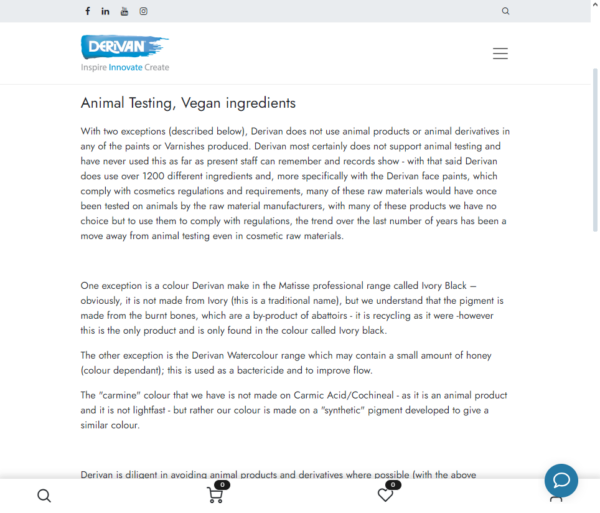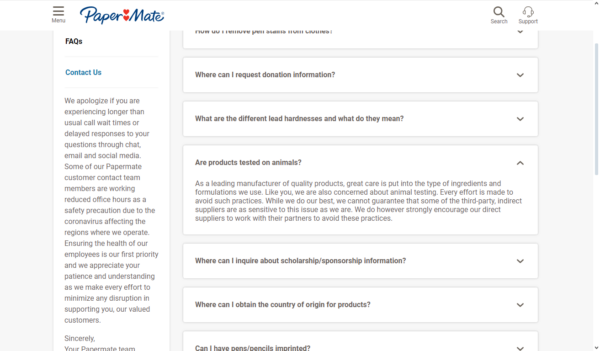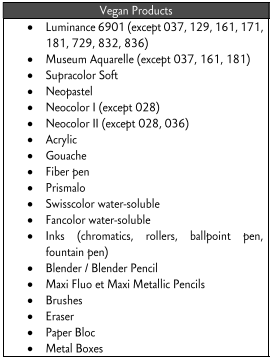Thank you to my reader M, for letting me know that Derivan have their cruelty-free statement now up on their website.
Here you can find Derivan’s statement.

Source: reader mail; Derivan website
Derivan’s listing in my compendium.
Thank you to my reader M, for letting me know that Derivan have their cruelty-free statement now up on their website.
Here you can find Derivan’s statement.

Source: reader mail; Derivan website
Derivan’s listing in my compendium.
Recently I was asked about Holbein again and whether only the pigments for the coloured pencils get dispersed with a small amount of animal fats/ oils.
I looked up my correspondence from 2017 and from October and November of 2023.
Their reply of March 2017 does not conclude only the pigments in the coloured pencils were meant but the reply was about pigments used in their products.
In November 2023, they let me know, that back in 2017, they only considered the pigments in the coloured pencils not all the ingredients used in the coloured pencils. They confirmed in Oct and Nov 2023, that also the wax used in the coloured pencils was of animal origin (animal fat).
We cannot automatically deduce only the pigments used in the coloured pencils product line were dispersed with animal fat/oil. It was not specified in 2017 and in Okt and Nov 2023 there is only the comparison drawn that they looked only at the pigments in the coloured pencils not the other ingredients used for the coloured pencils.
They still are learning about what is vegan/ free of animal derivatives and the nuances. Back in 2017, being approached with the topic was new to them.
They used the past tense in their correspondence from late last year (2023), so I do not know, whether they have changed ingredients and the material used as surfactant to disperse the pigments.
A small side note: in March 2017, brush cleaners contained squalene from deep sea sharks (Brush Cleaner LT and Odorless Brush Cleaner); some products contained bone black, ox gall or animal based glue. (again old information from 2017)
Touching the cruelty-free topic, they stated in Nov 2023, they themselves do not test on animals.
Here is my Holbein compendium entry.
Source: Mail contact
I was asked about oil paints the other day. Unfortunately for oil paints, I have only a few products to mention, and not a vast variety.
In 2022, Faber Castell’s Creative Studio oil paints set and Faber Castell’s tempera oil paints were free of animal derivatives.
In September 2023, I received the information that Caran d’Aches’ entire Neopastel line was free of animal derivatives.
Faber Castell Compendium entry
Winsor and Newton information – status: December 2024
Summary of Winsor & Newton and Colart’s response:
Some of Winsor & Newton’s products contain animal derived ingredients, such as their Ox gall medium.
The majority of their raw materials do not contain animal derivatives, however they cannot guarantee for their products to be completely free of animal derivatives, if animal based raw materials are present at the manufacturing site or raw materials come into contact with material of animal based origins in the supply chain.
For this reason, they cannot confirm any of their products to be certified “vegan-friendly”/ being completely free of animal derivatives.
The paint industry in the EU and UK do not test products on animals, though chemicals for all chemical products may have been tested historically due to EU and UK regulations.
Finished products are never tested on animals. Hazardous classification is determined through available information.
They are in the process of gathering information on their supply chain of all their products’ formulations to be able to classify some of their products to be free of animal derivatives /vegan-friendly in the future.
Source: mail contact

on their website I found out, that they are a Newell brand, and you’ll find their stance on animal testing in their FAQ list.
Direct quote from Papermate’s list of FAQs as of Dec 7th, 2023 :
“As a leading manufacturer of quality products, great care is put into the type of ingredients and formulations we use. Like you, we are also concerned about animal testing. Every effort is made to avoid such practices. While we do our best, we cannot guarantee that some of the third-party, indirect suppliers are as sensitive to this issue as we are. We do however strongly encourage our direct suppliers to work with their partners to avoid these practices.”
You find my information sheet, I send out to all the companies, here.
Finally, here you will find my 2017 post on company family trees, which mentions Newell brands.
sources: company websites, mail contact
I was asked for advice about the differences of Luminance and Polychromos coloured pencils. First of all, I would like to say, if you have the chance to try both out, do it and see what fits your needs best.
They have both great lightfastness, the Polychromos range is bigger with 120 pencils. The Polychromos are a harder coloured pencil and they are oil based. The Luminance coloured pencils are wax based, of a creamy consistancy. You also have to check for exceptions with the Luminance range, not all are free of animal derivatives ( exceptions ).
Generally, what I found was:
for Luminance (Caran d’Ache):
for Polychromos (Faber-Castell):
Luminance and Polychromos apply both well on top of watercolour, with gentle touch on top of gouache (with more pressure the gouache gets grated off) and on top of matte acrylics.
It is truly up to your own preference, what colour shades you need and the purpose you need them for. I use both.
For pencil dust removal, I mostly use a vegan baby kabuki make-up brush , which is great to get the pencil dust off of small areas. For larger areas I use a brush with handle, which is called “Zeichenbesen” in German. It looks like the brush you use with a dustpan (or a short handled toothbrush). If you dust with your hand, you risk smudging.
Another option are the watercolour pencil ranges (Albrecht Dürer and Supracolour Soft are my examples), which apply creamier compared to e.g. the Polychromos.
You find my latest Caran d’Ache blog post here ; and my compendium entry. Remember, not all Luminance coloured pencils are free of animal derivatives, there are exceptions.
My latest blog post about Faber-Castell is over here , and there is also my compendium entry.
Hello there,
today I am asking you for advice. A reader approached me about vegan encaustic wax, an alternative to beeswax. I never stumbled upon it so far. I do know that soy wax gets used as alternative in candles, but would it work for encaustic? Could you use soy wax and colour it with melted crayons e.g. Caran d’Ache’s Neocolor I s (except 028) or Faber-Castell’s studio oil pastels? Is that a thing? Could you McGuyver it like this?
What wax would work as encaustic substitute to beeswax?
I only know of soy wax in candles and in cosmetics of candelilla, carnauba, berry wax and there is also sunflower wax.
If anyone here knows about a brand that offers vegan encaustic wax or if you have your own experiences with it, I would like to hear from you.
I am very glad to be the messenger of such good news.
Caran d’Ache sent me their certificate of compliance .
I contacted them for products free of animal derivatives – including manufacturing process- and for their cruelty-free status. And good tidings I bring.
Please see the Caran D’Ache certificate of compliance and pay attention to exceptions in product lines. Some products contain the pigment ivory black, which is of an animal source.
Neither products nor raw materials get tested on animals.
Product lines free of animal derivatives (with exceptions of products containing the pigment ivory black):

Source: mail contact
I initially contacted Holbein back in 2017 and now did so again, to see whether there might have been some changes to make their coloured pencils ingredients now suitable. Unfortunately, it hasn’t changed. Back then I was informed of the use of animal fats to disperse the pigments. As of now, they cannot give any guarantee.
No further information was disclosed.
So here is my up to date listing for my compendium:
manufacturer: Holbein
currently no products free of animal derivatives available
cruelty-free level: no information disclosed
I am sorry about the disappointing news. I hope there will be changed in the future and I will circle back to them in some years.
source: mail contact
Cruelty-free has a broader spectrum of meaning. Just like the word “vegan” it is not set in stone and has no universally accepted set terminology. Is is open to interpretation.
In its foremost use, in all things “vegan” and animal related, it applies to being “free of animal testing”.
You can find my other latest article about this topic over here. And below you find a short overview.
On product packaging you will find this word, for example. Which means, a company makes the claim that the product is free of animal testing. If a company makes no further statements, this term should only be applied to this finished product, not its manufacturing process, not a whole product range of a company nor the company’s overall stance on animal-testing.
cruelty-free labelling and levels concerning animal testing:
This is how it is mainly viewed and used, but it is not the only interpretation. A reader recently pointed out to me that Faber-Castell produced a meat signing pen and could therefore not be seen as cruelty-free. You find my brief post about this over here.
Although this pen might have been free of animal derivatives (speculation for this explanation, I do not have any detailed information other than Faber-Castell stating this year that most of its products are free of animal derivatives), and the company might be free of animal testing, the pen’s intended use was connected to animal suffering.
Can a company be even free of any kind of cruelty in a broader sense that means more than ” animal testing”?
Most art and writing material suppliers do offer a range of products and not only products that are free of materials of an animal source.
Products containing
None of these things are cruelty-free in a broader sens; at this point, only concerning animals.
It would be a rare thing to find a brush company solely dedicated to producing brushes that are vegan; meaning their entire product range being free of animal derivatives.
Unless a company only sells all the way vegan products and has a defined on all level applying cruelty-free (animal sense) ethic, there will have been animal suffering.
Now the question is how many there actually are out there free of any kind of suffering attached to raw materials.
Another point or part of this is, companies having different tiers of product “quality”, if you will. They have e.g. crafting and school supplies, art supplies of different levels (beginner, hobby, student, artist /professional) and their fancy high-end tier. Offering e.g. leather bound fountain pens and leather bound sketch- and notebooks. Leather rolls for your coloured pencils, … . Undeniably, there has been animal suffering involved. Even, if claimed, the hides, bone ash etc. being leftovers from the meat industry.
Unfortunately, we do not live in an utopian world, void of animal suffering and cruelty against them. Mankind cannot even keep from it, concerning each other. How can we even expect them to muster up some form of acknowledgement and concerns for other beings and mother earth itself.
Which leads me to”cruelty-free”‘s , the meaning concerning humans.
Generally, we can think of
Although all the points above are important, child labour is standing out.
You will certainly stumble over child labour, if “Mica” is involved. Back some years ago, I mentioned Refinery 29’s short documentary about it and I also wrote a post about a company here, using “ethically” sourced Mica, their supplier being part of the “Responsible Mica Initiative”, working against child labour.
In the last week I happened upon a documentary on the channel 3SAT about said topic and initiative in India. The chairwoman informed the reporter that it does not mean, villages, areas, mines involved, are guaranteed free of child labour. It means they are working towards it, but it is not a guarantee, you won’t find a child at a mine, even if the initivative is working with people in the villages surrounding the mine.
The chairwoman also mentioned, natural Mica should not be avoided because it would take the lifelihoods of entire regions in India and Madagascar.
Some companies have changed to using synthetic Mica, e.g. Lush.
It still comes as a shock though, that the initiative does not come as a guarantee of no child labour .
Suprising is Mica’s different kind of use. Computer /phone companies, e.g. Samsung using Mica; drill holes being filled with it, some companies put it in toothpaste for optics and the list goes on. You only can ask why? How are we supposed to know, and what reasoning is happening, that companies are stuffing Mica into all those products? If it is not mentioned e.g. on a packaging for make-up or toothpaste, we won’t even be aware of it. A reason given for toothpaste being for optics? I don’t want to find titaniumdioxide in anything else but my art supplies; we art realm inhabitants have been aware of its carcinogen properties, because product packaging and information literally warns of it. I don’t want it in toothpaste and I certainly don’t want Mica in it. Who needs shimmery toothpaste? No one.
What company can be free of any form of cruelty, it can assume?
We can only keep on learning; and we can only keep on doing the best we can, acknowledging and adapting to new information we stumble upon.
The documentary I mentioned was aired on 3Sat on September 15th, 2023, when I was able to watch part of it. The reporter is Anne-Sophie Galli and the German name of the documentary was ” Glitzermineral Mica – Kinderarbeit für unsere Autos, Handys und Kosmetik” , translated : ” Shimmer material Mica – child labour for our cars, cellphones and cosmetics/ make up”. It was previously aired earlier this year here on youtube. There are unfortunately only German subtitles available at the moment.
For more information about animal based raw material, see my information sheet (German Version).